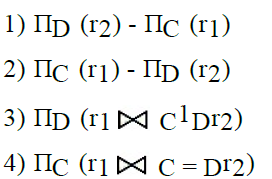Welcome to the DBMS MCQs Page
Dive deep into the fascinating world of DBMS with our comprehensive set of Multiple-Choice Questions (MCQs). This page is dedicated to exploring the fundamental concepts and intricacies of DBMS, a crucial aspect of GATE CSE Exam. In this section, you will encounter a diverse range of MCQs that cover various aspects of DBMS, from the basic principles to advanced topics. Each question is thoughtfully crafted to challenge your knowledge and deepen your understanding of this critical subcategory within GATE CSE Exam.
Check out the MCQs below to embark on an enriching journey through DBMS. Test your knowledge, expand your horizons, and solidify your grasp on this vital area of GATE CSE Exam.
Note: Each MCQ comes with multiple answer choices. Select the most appropriate option and test your understanding of DBMS. You can click on an option to test your knowledge before viewing the solution for a MCQ. Happy learning!
DBMS MCQs | Page 10 of 11
Explore more Topics under GATE CSE Exam
1. 9679, 1989, 4199 hash to the same value
2. 1471, 6171 hash to the same value
3. All elements hash to the same value
4. Each element hashes to a different value

(Note: r is the rename operator). The condition in join is "(sex = female ^ x = male ^ marks ≤ m)"

The goal of concurrent execution is
T1 : R(X); T2 : R(X); T1 : w(x); T1 : r(y); T2 : w(x); T2 : Commit; T1: w(y) ; T1: Commit
Which of the following is true?
T₁: r₁ (A); w₁(A); r₁ (B); w₁(B)
Find the no. of conflict serializable schedules that can be formed over T₁ and T₂.
Suggested Topics
Are you eager to expand your knowledge beyond DBMS? We've curated a selection of related categories that you might find intriguing.
Click on the categories below to discover a wealth of MCQs and enrich your understanding of Computer Science. Happy exploring!








